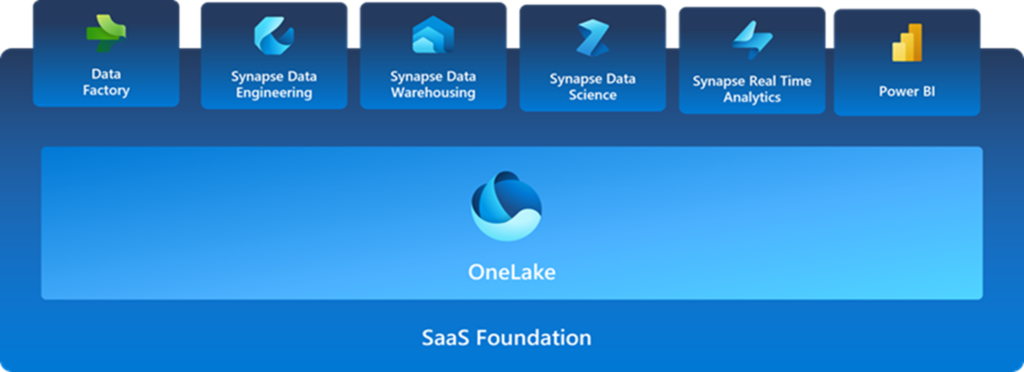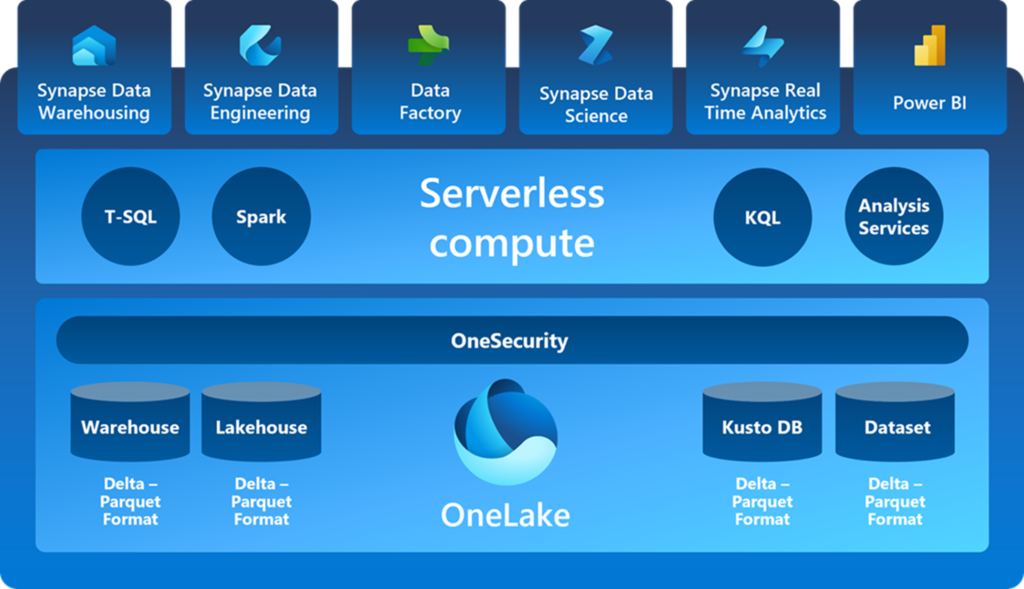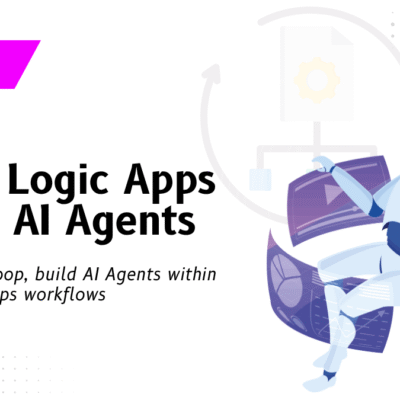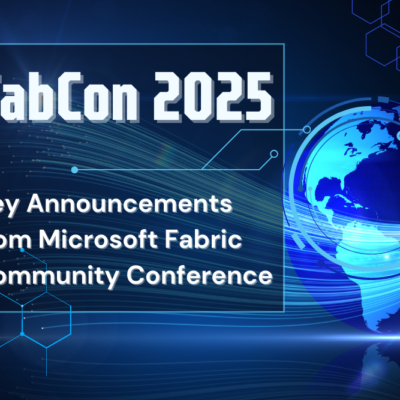Unleashing the Power of Microsoft Fabric: Revolutionizing Data Analytics

In the rapidly evolving world of data analytics, navigating through a multitude of tools and services can be overwhelming. That’s where Microsoft Fabric comes in. Born out of a vision to simplify and streamline data analytics workflows, Microsoft Fabric brings together a comprehensive suite of technologies under one unified umbrella. In this blog, we will explore the key features and benefits of Microsoft Fabric, and why it is poised to revolutionize the way organizations approach data analytics.

1. Simplifying Complexity
Data analytics environments often suffer from complexity due to the multitude of tools and services available. Microsoft Fabric addresses this challenge head-on by combining various powerful technologies, such as Power BI, Azure Data Factory, Azure Synapse, OneLake, Dataflow, Data Activator, and Purview, into a single, integrated platform. No longer do data professionals need to grapple with licensing complexities or switch between disparate tools. Microsoft Fabric offers a unified environment, simplifying operations and enabling organizations to focus on driving impactful results.
2. Harnessing the Power of Integration
One of the standout features of Microsoft Fabric is its seamless integration of technologies, which were previously used in isolation. Let’s delve into some of the key components of Microsoft Fabric and how they collaborate to empower organizations:

2.1. Storage: OneLake
At the heart of Microsoft Fabric lies OneLake, a powerful data lake technology that provides a unified storage solution. By eliminating the need for multiple data lakes across regions, OneLake reduces complexity and enables efficient data management.
2.2. Data Integration: Azure Data Factory and Dataflow
Azure Data Factory, the successor to SQL Server Integration Services, offers scalable and efficient Extract, Transform, Load (ETL) capabilities. Dataflow, powered by Power Query technology, complements Data Factory by providing comprehensive data transformation functionalities. The integration of these tools within Microsoft Fabric ensures smooth data integration across the analytics pipeline.
2.3. Data Engineering and Warehousing: Synapse
Azure Synapse, a robust data engineering and warehousing solution, empowers organizations to build scalable infrastructures. By leveraging the Lakehouse approach and combining the capabilities of OneLake and Synapse, data engineers can efficiently manage and analyze large-scale data projects.
2.4. Data Science: Synapse
Within Microsoft Fabric, data science is seamlessly integrated as a workload within Synapse. Data scientists can utilize a wide range of tools and features, including data wrangling, model building, and experiment tracking. This integration enables end-to-end data science workflows and accelerates insights generation.
2.5. Real-time Analytics: Synapse
Microsoft Fabric includes real-time analytics capabilities through Synapse. Organizations can analyze streaming data using event streaming technologies like IoT or Event Hubs, load data into KQL DB and OneLake via mirroring, run ML models for experiments, and visualize the results using Power BI.
2.6. Business Intelligence: Power BI
Power BI, a leading analytics technology, seamlessly integrates with Microsoft Fabric. It enables data analysts to connect to various data sources, perform data preparation and modeling, and create insightful visualizations. Power BI becomes even more powerful within Microsoft Fabric, leveraging OneLake storage for enhanced performance.
2.7. Action Platform: Data Activator
Data Activator, a new tool offered as part of Microsoft Fabric, automates actions based on data events. It allows users to define triggers and actions, enabling seamless transition from insights to actions within the analytics workflow.
2.8. Governance: Purview
Purview, an advanced data governance solution, is an integral part of Microsoft Fabric. It helps organizations govern, protect, and manage their data estate. The Purview Data Catalog scans artifacts within Microsoft Fabric, providing comprehensive visibility and control over data assets.
3. Benefits and Impact
3.1. Simplified Complexity
Microsoft Fabric brings together a comprehensive suite of data analytics technologies under one umbrella. This consolidation simplifies the complex landscape of data analytics, reducing the need for organizations to navigate multiple tools, platforms, and licensing plans.
3.2. Seamless Integration
By integrating technologies such as Power BI, Azure Data Factory, Azure Synapse, and more, Microsoft Fabric enables seamless collaboration and data sharing across different functions and teams within an organization. It eliminates silos and fosters a unified approach to data analytics.
3.3. Enhanced Productivity
With Microsoft Fabric, data engineers, data scientists, and data analysts can work in a unified environment, leveraging shared resources, standardized security, and consistent configurations. This integration eliminates the need for context-switching between disparate tools, leading to improved productivity and accelerated time-to-insights.
3.4. Unified Data Management
Microsoft Fabric provides a centralized data lake, known as OneLake, for storing both structured and unstructured data. This unified data foundation simplifies data management, making it easier to ingest, process, and analyze large volumes of data from diverse sources.
3.5. Advanced Analytics Capabilities
By combining technologies like Power BI, Azure Synapse, and Dataflow, Microsoft Fabric empowers organizations with advanced analytics capabilities. From data integration and engineering to data science and real-time analytics, Fabric offers a comprehensive suite of tools for extracting actionable insights and driving data-driven decision-making.
3.6. Enhanced Security and Governance
Microsoft Fabric incorporates governance features such as Purview, which helps organizations govern, protect, and manage their data estate. With Purview’s data catalog capabilities, organizations can maintain visibility and control over their data assets, ensuring compliance with regulatory requirements and data protection policies.
3.7. Scalability and Flexibility
Fabric’s cloud-native architecture enables organizations to scale their data analytics infrastructure seamlessly. Whether it’s scaling up data warehousing capabilities or accommodating increasing data volumes, Microsoft Fabric provides the flexibility needed to adapt to evolving business needs.
3.8. AI-Driven Insights
Leveraging the power of AI and machine learning, Microsoft Fabric allows organizations to harness the full potential of their data. With AI capabilities integrated into Fabric’s various components, organizations can automate processes, detect anomalies, optimize resource allocation, and unlock valuable insights from their data assets.
3.9. Collaboration and Knowledge Sharing
Microsoft Fabric fosters collaboration and knowledge sharing within organizations. By providing a unified environment, it enables cross-functional teams to work together, share insights, and leverage each other’s expertise, leading to more informed decision-making and better outcomes.
3.10. Future-Proofing
As an umbrella offering built on established and trusted technologies, Microsoft Fabric provides a future-proof solution for organizations. With Microsoft’s ongoing investments and commitment to innovation, Fabric ensures that organizations can stay at the forefront of data analytics advancements and take advantage of emerging technologies.
By combining these technologies under the Microsoft Fabric umbrella, organizations can unlock the full potential of their data, drive innovation, and gain a competitive edge in today’s data-driven landscape.
4. How Organizations Leverage Microsoft Fabric:
Let’s explore how organizations in different industries can harness Microsoft Fabric’s features to their advantage:
4.1. Healthcare Organization
A healthcare organization can harness the full potential of Microsoft Fabric’s features to revolutionize patient care and medical research. By utilizing Fabric’s data lake, they can consolidate patient records, medical imaging data, and research datasets in a secure and centralized environment. This integration allows researchers to collaborate and gain insights from shared data, leading to advancements in medical research and improved patient outcomes. Additionally, by leveraging Fabric’s AI capabilities, healthcare organizations can automate processes like anomaly detection in patient data, optimize resource allocation, and enhance personalized treatment plans.
4.2. Financial Institution
For financial institutions, Microsoft Fabric provides a comprehensive analytics platform that can transform their operations. By integrating data from various sources into Fabric’s unified architecture, they can gain a holistic view of their customers, transactions, and market trends. Fabric’s AI capabilities enable financial institutions to detect anomalies and potential fraud in real-time, leading to enhanced security and reduced financial risks. Moreover, by leveraging predictive analytics, financial institutions can optimize customer segmentation, personalize offerings, and proactively address customer churn, ultimately driving customer satisfaction and loyalty.
4.3. Manufacturing Company
Manufacturing companies can harness the power of Microsoft Fabric to optimize their production processes and improve overall efficiency. By integrating data from production lines, supply chains, and quality control systems into Fabric’s data lake, they can gain real-time visibility into their operations. Fabric’s AI-powered analytics can identify bottlenecks, predict maintenance needs, and optimize production schedules. By leveraging these insights, manufacturing companies can reduce costs, improve product quality, and enhance customer satisfaction through timely deliveries and streamlined processes.
4.4. Education Institution
Education institutions can leverage Microsoft Fabric to transform their educational processes and drive better outcomes for students. By centralizing student performance data, attendance records, and feedback from various learning management systems into Fabric’s data lake, they can gain comprehensive insights into student engagement, learning patterns, and individual needs. This enables personalized learning experiences, targeted interventions, and data-driven decision-making by educators and administrators. By harnessing Fabric’s analytics capabilities, education institutions can improve educational outcomes, identify areas for improvement, and optimize resource allocation.
4.5. Marketing Team
Microsoft Fabric empowers marketing teams with advanced analytics capabilities to drive impactful campaigns and optimize marketing strategies. By integrating campaign performance data, customer segmentation, and social media analytics into Fabric’s platform, marketers can gain a deep understanding of their target audience. Fabric’s AI capabilities enable marketers to extract actionable insights, identify trends, and personalize marketing initiatives. By directly applying these insights within familiar tools like Excel, PowerPoint, and Teams, marketing teams can collaborate effectively and make data-informed decisions to maximize marketing ROI and drive business growth.
5. Future Outlook
Looking ahead, Microsoft Fabric has the potential to reshape the data analytics landscape. As organizations embrace the power of simplicity, Microsoft Fabric offers a comprehensive solution that maximizes productivity and minimizes complexities. By unifying powerful technologies, Microsoft Fabric empowers organizations to unlock the full potential of their data assets and drive innovation in the digital era.
6. Conclusion
Microsoft Fabric represents a paradigm shift in the world of data analytics. By bringing together leading technologies under one umbrella, it revolutionizes the way organizations approach data analytics, simplifies operations, and drives impactful results. As organizations strive to stay ahead in an increasingly data-driven world, Microsoft Fabric emerges as a game-changer, paving the way for a future where data analytics is powerful, collaborative, and transformative. It’s time to explore Microsoft Fabric and unlock the true potential of your data-driven journey. Get started with Microsoft Fabric by visiting https://learn.microsoft.com/en-us/fabric/get-started/fabric-trial.


